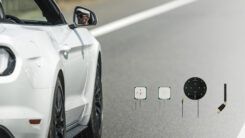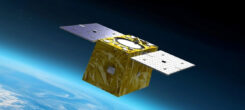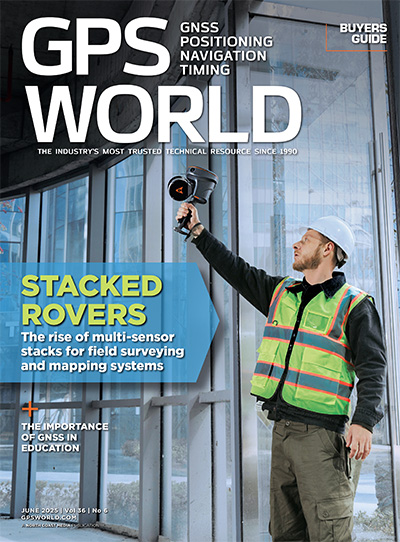Take It to the Limit

 |
Speed determines the severity of traffic accident injuries, more than almost any other factor.
Seventy percent of pedestrians hit by a car travelling at 50 kilometres per hour will die. On the other hand, if the car is travelling at 30 kilometres per hour, 90 percent will survive. Keeping drivers within posted speed limits takes on added importance in urban areas, where cars, buses, and trucks interact with pedestrians, cyclists, and children.
For 20 years, Swedish cities have tried to reduce vehicle speed in urban areas. In the late 1970’s, they placed speed bumps, also known as sleeping policemen, in strategic traffic areas. Speed bumps do reduce speeds, however these physical safety measures mean large investment and costly maintenance for local authorities. Further, such “traffic calming” devices cannot adapt to temporary changes such as hazardous road conditions, traffic congestion, or poor weather.
The Swedish Intelligent Speed Adaptation (ISA) project supplements such traditional methods with innovative technical solutions, including in-vehicle systems to tell the driver when to slow down, and methods to adapt the speed limit to temporary road conditions.
In autumn 1997, the Swedish parliament approved a government proposal to base all traffic safety work on “Vision Zero,” setting a goal of zero road fatalities or serious injuries. In 1998 the government directed the Swedish National Road Administration (SNRA) to undertake large-scale ISA trials in urban areas, based on the experience acquired from previous smaller-scale trials.
Street trials. The cities of Borlange, Lidkoping, Lund, and Umea currently conduct the ISA trials, each responsible for implementation in its own jurisdiction. The SNRA coordinates the project at the national level through project management, technical support and collating the results from the different cities.
Different categories of road-users, all volunteers, participate in the trials. Private individuals comprise the largest group, but commercial drivers in both private and public transport also constitute a significant number.
The project
The SNRA has invested 75 million Swedish Kronor (E8.12 million) between 1999 and 2001 in the ISA project, and equipped nearly 5,000 cars with smart, supporting, voluntary systems to help motorists keep within speed limits. 970 of these cars in Borlange, Lidkoping, and Lund carry Limit Advisor systems using GPS receivers.
Overall, the project aims to increase our knowledge of
- 1. motorists’ use and attitudes
- 2. traffic safety and environmental effects
- 3. integration of high technology systems in cars
- 4. prerequisites for the large-scale use of road informatics.
Project engineers considered different methods for speed limit detection:
- 1. GPS-based systems
- 2. radio transmitter/receiver (a transmitter on or near the speed limit sign sending information to in-vehicle receiver)
- 3. infrared (same method)
- 4. transponder systems (same method)
- 5. video (in-vehicle camera and in-vehicle intelligence capable of recognising speed signs).
- 6. Project developers chose a GPS-based system for Borlange, Lidkoping and Lund, and a radio transmitter/receiver system in Umea.
- 7. Two HMI methods are possible:
- 8. indicative, simply or passively informing the driver of a speeding situation
- 9. active support, interfering more directly in vehicle operations.
- 10. The GPS-based systems installed in the three cities test both interface methods.
The active accelerator Limit Advisor system provides the driver with a mechanical feedback through the accelerator about driving speed. When the driver exceeds the speed limit, he or she feels a slight resistance from the accelerator. The accelerator resistance functions only in an advisory capacity, as the driver can override this feedback at any time by pressing harder. If the driver wishes to observe the speed limit, simply resting the foot on the resisting pedal will keep the car at the correct speed.
The Limit Advisor’s major advantage is in environments where pedestrians, cyclists and children interact with heavy and fast moving vehicles. It functions especially well in busy city centres, housing areas, and around schools and daycare centres, providing feedback with a minimum of driver distraction.
GPS and digital map
The Limit Advisor consists of a mechanical unit installed in the engine compartment on the cable between the accelerator pedal and the engine. A navigator unit is located underneath the dashboard, containing a digital map with embedded speed limits. The system uses a GPS receiver to follow the vehicle’s itinerary on the digital map.
The digital map makes it possible to have different speed limits on the same street, for example, 50 kilometres/hour in one direction and 30 kilometres/hour in the other direction. Each map vector is shaped in a special way to make the map-matching work. Future digital maps will include other important traffic information along with commercial information.
While inside the digital map’s coverage area, the Limit Adviser constantly monitors the speed limit, compares it with vehicle speed, and instructs the mechanical unit to activate accelerator pedal resistance when over-speed. The system cannot be disengaged while inside the test area, only overruled by pressing harder on the accelerator. Outside the map’s coverage area, the driver may use either of two options:
1. conventional “cruise control” in which the driver selects a speed using buttons on the display, and the system does not perform any limit advising
2. voluntary ISA function, where the driver predetermines the maximum speed limit using the unit buttons and engaging the Limit Advisor function.
Informative. Some speed advisory systems under study during the trials also contain a passive HMI, through a small box attached to the dashboard. When the car exceeds the speed limit, a red light blinks and sound signal beeps. Some vehicles also contain a display showing the actual speed limit within the test zone.
 Lund, 290 test vehicles, all GPS-driven active accelerator Lund Municipality has made a commitment to provide more bicycle lanes to its citizens. Further, its historic and vulnerable city centre has very limited road space. Lund thus views the ISA trial as a possible way to improve the traffic environment and develop alternative solutions to road rebuilding. The Lund Institute of Technology has pioneered ISA research studies since the early 1980���s. |
Quality assurance. Some transport services, including schoolbuses and taxi services for elderly or disabled persons, are also testing quality assurance systems. If the driver fails to reduce speed despite being warned by the blinking light and sound signal for 10��15 seconds, the system registers and stores the incident information. The client (the municipality) then gets a report as to whether or not the transport company has fulfilled its contract terms regarding safe driving.
Speed limit changes
In a community, the road network and traffic patterns change over time. The forces effecting these changes could be environmental, road safety aspects, or efficiency. As an intrinsic part of this process, new road signs are put up and old ones removed. Speed limits may also change over time.
Further, different periods of the day may call for different speed limits. For example, when schools are open traffic should be controlled at much lower speeds to avoid accidents. When schools are closed, the speed could be less restricted. In this fashion, speed limits may change in a cyclical manner.
Road work often calls for temporary speed limits, and crews will set up temporary signs.
 Lidkoping, 280 test vehicles, 130 GPS-driven active accelerator, 150 GPS-driven sound and light displays Local surveys have shown that while nine out of ten Lidkoping citizens think observing the speed limit is important, six out of ten admit to driving too fast on occasion. Lidkoping municipal authorities want to use the ISA trial to identify alternative to traditional traffic calming measures. |
These situations are all characterised by the fact that a planning process precedes speed limit modifications, and thus changes may be known and scheduled in advance. The Swedish ISA system makes it possible to update the speed limits in vehicles’ digital maps either wirelessly by a cellular network, or by periodic cable downloads to the vehicle unit.
In contrast, traffic accidents, traffic jams, and hazardous road conditions exemplify situations where instantaneous changes to the speed limit might greatly enhance traffic safety. In these more dynamic situations, only wireless broadcast could perform speed limit updates to in-vehicle digital maps .
System Design
One of the providers of in-vehicle units in this project has developed, as a commercial product, a client/server based car navigation system that does not require a CD-ROM. The company designed a scalable server that in a clustered version can generate up to 2,000 complex routes per second. On the client side there is a low-cost car navigation unit containing a GPS receiver. a microprocessor and a mobile phone.
The ISA project utilises this car navigation unit without hardware changes except in Lund, where additional memory was required for extended logging of additional data requested by the government.
 Borlange, 400 test vehicles, all GPS-driven sound and light displays Borlange, actively commited to speed advising systems, has placed speed bumps in busy streets, and led development of digital maps of city street networks. In 1998 it operated a small-scale ISA trial with 20 commercial drivers. |
As an evaluation and research project, the ISA in Borlange and Lund calls for comprehensive logging of these parameters:
- 1. day and time
- 2. position, speed and direction from GPS
- 3. speed from odometer
- 4. speed limit from the digital map
- 5. GPS status (number of satellites tracked)
- 6. street link identifier.
The Borlange mobile data link is also used to upgrade the vehicle unit’s software and the digital map. Further, predefined changes could be activated wirelessly. For example, if it is foreseen that a particular speed limit will be changed or a speed limit will be set up in particular place, such changes can be activated individually without downloading a complete new map each time.
The wireless data connection is also used to update system software in the navigation unit.
For each road segment, the speed limit is stored as an attribute. In principle the solution is then very simple. By use of GPS the road and the actual road segment is identified and the corresponding speed limit is fetched from the map data-base and presented to the driver through the active accelerator or shown on a display.
As a consequence of inaccurate positions from GPS receivers, due to a variety of factors, the reality is much more complex, especially in urban environments. A number of inherent shortcomings of GPS must therefore be taken into account when implementing an effective speed limit advisor.
- 1. GPS signal reflection form buildings (multipath)
- 2. signal loss in tunnels, urban canyons, and dense vegetation
- 3. receiver limitations such as position accuracy, maximum jerk (allowed rate of change of acceleration), and so on
- 4. long time to first fix (TTFF) under poor signal conditions.
Map-matching. Map-matching for speed limit advisors differs markedly from map matching for car guidance. In the latter case, the route for the vehicle to follow is given beforehand. The problem then consists of using map data to filter the GPS-provided data, and using the dead reckoning system to minimise the difference between actual position and system-calculated position. Another function of map-matching in a navigation system is to detect “off-route” conditions.
 Umea, 3,900 test vehicles, roadside transmitters, sound and light displays Umea has worked on safer traffic environments for several years with speed bumps and limit reductions. In 1996, it conducted a smaller-scale ISA trial with 100 vehicles. |
In a speed-limit advisor system, the intended route not known beforehand. The system must therefore decide which route you are actually taking. At each intersection, the system must decide, quickly and reliably, which road the driver chose. We have employed statistical methods and fuzzy logic for this purpose. Map-matching can improve the accuracy of the position in much the same way as in the navigation case previously described.
Dead reckoning. The navigator is attached to the odometer by a self-adjusting interface. This interface automatically takes care of the wide variation in output voltages and number of pulses per turn between different car models. After installation, the car is driven a few kilometres for calibration, setting the coefficient for calculation of distance travelled based on odometer pulses.
Change of direction is very important for dead reckoning. The inputs for dead reckoning are the signals from the odometer, the gyro and the GPS receiver.
System Function
The system designed for the ISA trial has its own in-vehicle central processing unit (CPU), capable of communicating with the positioning system. This CPU collects additional logged data, correlated with vehicle speed, such as the percentage by which the accelerator is pressed, and engine revolutions per minute (RPM). It can also provide measurement of brake and clutch depression, and note if the car is moving in reverse.
Data logged in the ISA trial is sent by GSM five times/second inside the test area, and once/second outside the test area (in Borlange, once/second inside and once/ten seconds outside). The log data is stored in the positioning-CPU, because it also collects the position. This position is the raw GPS-NMEA, and this is later compared with the digital map in the evaluation software written at Lund University, showing where drivers have gone too fast, and so on.
Required and obtained accuracy. The ISA project requires that the system distinguish between two streets separated by more than 12 metres. The local ISA projects and the system operator have independently verified 10-meter accuracy.
Evaluation
Post-trial evaluation of the ISA project will explore four different aspects:
- 1. What does the user think?
- 2. How can the technology be integrated with the driver?
- 3. What are the effects on safety and the environment?
- 4. What is the general attitude to traffic safety?
In principle, the evaluations will be based on comparative measurements, before, during, and after the introduction of ISA systems. There are relatively large design differences in the four trial areas and this will be taken into account when planning the field measurements and comparing the evaluation results.
We believe the Limit Advisor system is psychologically easier for drivers to accept than systems that are completely interventionist, that is, where the accelerator stops working once the maximum speed limit has been reached.
Today, we live in a society where stress forms part of most people’s lives. On a normal car journey in an urban area, it is often only possible to save a few seconds, perhaps as much as a minute or two, by driving too fast. The risks to driver, passengers, and others, including the risk of fines, are not proportional to the time savings.
Using ISA, smart technical systems can supplement traditional systems, helping motorists reach their
destinations smoothly, safely, and conveniently, and at the same time providing more security for other road users. Physical speed obstacles can be replaced with electronic “bumps,” and speed limits can be easily adapted to match prevailing, and dynamic, conditions.
International interest
Sweden has taken a leadership position in ISA. Researchers in Lund have been active in this area since the early 1980’s. Worldwide, only small-scale ISA trials have been conducted, and this, the first large-scale trial, is therefore being followed with anticipation by traffic researchers from all over the world.
Outside Sweden, Belgium, the Netherlands and the U.K. have made significant progress in this area. In 1999, trials involving a small number of cars equipped with ISA systems began in the latter two countries. To create the commercial potential for ISA, the project must be accepted internationally. Discussions about incorporating parts of this large-scale trial in an EU project are also underway.
Acknowledgements
The Limit Advisor was developed in cooperation with Professor Christer Hyd���of the Department of Traffic Technology at Lund University. Malin Theorin at Vagverket, the SNRA’s office for Intelligent Speed Adaptation, has during the course of the ISA trials provided significant coordination, supervision, and assistance.
Manufacturers
Imita AB (Lund, Sweden) is the system integrator for the ISA trials in Lund and Lidkoping. The company’s contact information is at <www.imita.se>. Itinerary Systems IS AB (Lund, Sweden) supplied the navigation units to the Limit Advisor and the complete indicative ISA systems to Borlange and Lidkoping. Its contact information is at <www.itinerary.com>. The Limit Advisor in-car systems use Trimble ACE III receivers.
;

















Follow Us